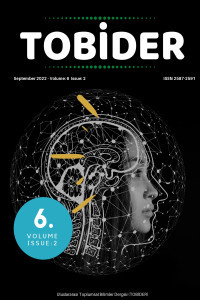“BEYLER, GERÇEK AMERİKA BU MU?”: YUNG WING, SUI SIN FAR VE YONE NOGUCHI’DE ÖTEKİLEŞTİRME VE IRKÇILIK
Birçok Asyalı göçmen Kaliforniya Altın Hücumu nedeniyle on dokuzuncu yüzyılın ortalarından sonlarına doğru Amerika’ya varmış ve doğrudan beyaz Amerikalıların tepkisi ile karşılaşmıştır. Asyalı göçmenlerin dışlanma ve ırkçılık deneyimleri dönemin kurgusal ve kurgusal olmayan edebiyatında karşımıza çıkar. Bu makalede Yung Wing’in My Life in China and America (1909), Sui Sin Far’ın (Edith Maud Eaton) “Leaves from the Mental Portfolio of an Euroasian” ve bazı yayımlanmış köşe yazıları (1910) ile Yone Noguchi’nin The American Diary of a Japanese Girl (1901) eserlerine odaklanılmaktadır. Bu üç eser Amerika’da Asyalılara karşı önyargının hâkim olduğu bir dönemde Asyalıların Amerikanlaşmasını temsil etmeleri açısından önem taşımaktadır. Bu makalede, Çinli Amerikalı ve Japon Amerikalı karakterlerin deneyimlerinin, beyazlığın bu eserlerdeki karakterler tarafından elde edilemez olduğunu öne sürdüğü tartışılmaktadır. Dahası, bu makale bu deneyimlerin topluma dahil etme ve ötekileştirme ikileminde işlediğini öne sürmektedir. Burada incelenen eserlerin bazılarında kurgusal olan ve olmayan karakterlerin kapsayıcı/dışlayıcı dili nasıl benimsedikleri incelenerek, makalede ırkçılık, vatandaşlık ve beyazlığın bu karakterlerin Amerikanlaşma süreçlerinin ayrılmaz bir parçası olduğu iddia edilmektedir. Ayrıca, Amerika’daki Çinli ve Japon göçmenlerin beyaz topluma asimile olamayan ötekileştirilmiş kişiler olarak muamele gördükleri bir dönemde, bu üç anlatının göçmenlerin yaşamlarına küçük bir pencere sunduğu da tartışılmaktadır.
“GENTLEMEN, IS THIS REAL AMERIKEY?”: MARGINALIZATION AND RACISM IN YUNG WING, SUI SIN FAR AND YONE NOGUCHI
Yogé Noguchi’s disillusioned character Morning Glory barely sets her foot on American soil as she exclaims “Gentlemen, is this real Amerikey?” (35). When she looks around her in great confusion to devour in the country she has dreamed of for so long, she cannot hide the first frustration of the immigrant upon arrival. Her “Meriken dream” becomes a “complete failure” (Noguchi, 35). Indeed, even though the heaven of opportunities promised the American Dream to immigrants, it did not protect them from the engrained racism in American society and the marginalization that accompanied it. Asian immigrants came in great numbers from mid- to late-nineteenth century due to the California Gold Rush, and they faced an immediate backlash by white Americans. The experiences of exclusion and racism also appear in fictional and non-fictional works of the period. This paper focuses on Yung Wing’s My Life in China and America (1909), Sui Sin Far’s (Edith Maud Eaton) Leaves from the Mental Portfolio of an Euroasian (1910), and Yogé Noguchi’s The American Diary of a Japanese Girl (1901). In the three works that are analyzed in this paper, the Chinese American and Japanese American characters suggest that acceptance by Americans into the society work on a conundrum of inclusion vs. marginalization.
Keywords:
Asian American, Yung Wing, Sui Sin Far, Yogē Noguchi, Marginalization Whiteness,
___
- Brodkin, K. (1998). How Jews became white and what that says about race in America. Rutgers University Press.Constitution Annotated: Analysis ad Interpretation of the U. S. Constitution. (n.d.). ArtI.S8.C18.8.4 Early Federal Laws on Immigration. https://constitution.congress.gov/browse/essay/artI-S8-C18-8-4/ALDE_00001258/
- Daniels, R. (1990). Coming to America: A history of immigration and ethnicity in American life. HarperCollins.
- Davis, S. F. (1914). Mississippi negro lore. McCowat-Mercer.
- Diana, V. H. (2001). Biracial/bicultural identity in the writings of Sui Sin Far. MELUS, 26(2), 159-186.
- Fanon, F. (1963). The wretched of the earth (C. Farrington, Trans.). Grove Press. (Original work published in 1961).
- Far, S. S. (1995). Mrs. spring fragrance and other writings. (Eds. A. Ling & A. White-Parks). University of Illinois Press. (Original work published in 1910).
- Franey, L. E., & Noguchi, Y. (2007). Introduction. In L. E. Franey & E. Marx (Eds.), The American diary of a Japanese girl: An annotated edition (pp. vii–xx). Temple University Press. http://www.jstor.org/stable/j.ctt14bt0gx.3
- Halverson, C. (2007). “Typical Tokio smile”: Bad American books and bewitching Japanese girls. Arizona Quarterly Volume, 63(1). 49-80.
- Harris, C. I. (1993). Whiteness as property. Harvard Law Review, 106(8), 1707-1791.
- Jacobson, M. F. (1999). Whiteness of a different color: European immigrants and the alchemy of race (1st ed.). Harvard UP.
- Jirousek, L. (2002). Spectacle ethnography and immigrant resistance: Sui Sin Far and Anzia Yezierska. MELUS, 27(1), 25-52.
- LaCapra, D. (2013). History, literature, critical theory. Cornell UP.
- Lowe, L. (1998). Immigrant acts: On Asian American cultural politics. Duke UP. (Original work published in 1996).
- Museum of Chinese in America. (n.d.). Yung Wing. https://www.mocanyc.org/collections/stories/yung-wing/ Noguchi, Y. (1902). American diary of a Japanese girl. Frederick A. Stokes (Original work published in 1901).
- Painter, N. I. (2011). The history of white people. W.W. Norton. (Original work published in 2010).
- Riis, J. A. (1997). How the other half lives. Penguin Books (Original work published in 1890).
- Roediger, D. R. (2006). Working toward whiteness: How America's immigrants became white: The strange journey from Ellis island to the suburbs. Basic Books (Original work published in 1985).
- Seethaler, I. C. (2011). Dressed to cross: Narratives of resistance and integration in Sei Shonagon's the pillow book and Yone Noguchi's the American diary of a Japanese girl. Ethnic studies review, 34(1), 185-198.
- Solberg, S. E. (1981). Sui Sin Far/Edith Eaton: First Chinese-American Fictionist. MELUS, 8(1), 27-39.
- The Extinction of Blue Eyes. (1870). The Emerald: An Illustrated Literary Journal, p. 152.
- Immigration History. (2019). The page act of 1875 (immigration act) forty-third congress. sess. ii. ch. 141. 1875. https://immigrationhistory.org/item/page-act/
- White-Parks, A. (1995). A reversal of American concepts of "other-ness" in the fiction of Sui Sin Far. MELUS, 20(1), 17-34.
- Wing, Y. (1909). My Life in China and America. Henry Holt Company.
- Worthy, Jr., E. H. (1965). Yung Wing in America. Pacific Historical Review, 34(3), 265-287.
- Başlangıç: 2017
- Yayıncı: Sadık Hacı
Sayıdaki Diğer Makaleler
ANTİK MEDENİYETLERDE MÜZİK VE DİNİ MÜZİK
DEPREMZEDELERİN DEPREM OLGUSUNU ANLAMLANDIRMA TUTUMLARINA DİNÎ VE SOSYOLOJİK BİR BAKIŞ
Hayrettin KARADENİZ, Yavuz Güven MET
BAKLÎ'NİN ʿARÂʾİSÜ’L-BEYÂN'INDA MARİFET KAVRAMI
KİTAP İNCELEMESİ: E. JAN ZÜRCHER’İN MODERNLEŞEN TÜRKİYE’NİN TARİHİ ADLI KİTABI
AŞK-I MEMNU’DA EBEVEYN-ÇOCUK İLİŞKİLERİ
ẔAḪÎRE-İ ḪÂREZMŞÂHÎ’DE AHLÂT-I ERBAA
TÜRKİYE’DE GÜNCEK EKONOMİK KRİZ: NEDENLERİ, ETKİLERİ VE SONUÇLARİ
MARGARET ATWOOD’UN SPEKÜLATİF FEMİNİST EKO-DİSTOPYASI DAMIZLIK KIZIN ÖYKÜSÜ ROMANINDA ZORUNLU ÜREME
